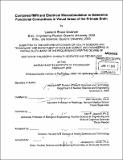| dc.contributor.advisor | Wim Vanduffel. | en_US |
| dc.contributor.author | Ekstrom, Leeland Bruce | en_US |
| dc.contributor.other | Harvard University--MIT Division of Health Sciences and Technology. | en_US |
| dc.date.accessioned | 2009-10-01T15:51:42Z | |
| dc.date.available | 2009-10-01T15:51:42Z | |
| dc.date.copyright | 2009 | en_US |
| dc.date.issued | 2009 | en_US |
| dc.identifier.uri | http://hdl.handle.net/1721.1/47848 | |
| dc.description | Thesis (Ph. D.)--Harvard-MIT Division of Health Sciences and Technology, 2009. | en_US |
| dc.description | Includes bibliographical references (p. 69-83). | en_US |
| dc.description.abstract | The use of functional magnetic resonance imaging (fMRI) to study the non-human primate brain has been developed over the past decade. Primate fMRI has many attractive features: it allows validation of previous homology assumptions between humans and monkeys, provides a model to combine imaging with invasive techniques to directly manipulate the brain, and can guide other modalities, such as electrophysiology, to new areas of interest. The frontal eye field (FEF) is a well-studied node in the oculomotor network, involved in visual target selection and saccade planning. Recent evidence has implicated FEF as a possible source of feedback signals that modulate visually-driven activity in posterior cortical areas, such as during the deployment of spatial attention. The goals of this thesis were extend the unique aspects of primate fMRI by combining it with simultaneous, intra cortical microstimulation (EM), and to use these new methods to measure how local, artificially-increased FEF output could modulate visually-driven fMRI activity in earlier cortical regions. The first outcome of this thesis was a novel form of functional tractography. FEF-EM below the threshold needed to evoke saccades yielded robust, focal fMRI activity in cortical and sub cortical structures connected with FEF. The second outcome was a demonstration that subthreshold FEF-EM produced retinotopically-specific enhancement and suppression of the representation of a stimulus presented at the saccadic endpoint, or movement field (MF), of the stimulated FEF site. Modulation occurred at multiple levels of the visual system and the signals presumably causing it appeared to be gated in the earliest cortical areas by bottom-up activity. The third outcome was a characterization of how stimulus intensity altered these modulations. | en_US |
| dc.description.abstract | (cont.) The luminance contrast of a stimulus presented in the MF was systematically varied to generate contrast response functions for many cortical areas, which were compared with existing data. Sub-threshold FEF-EM increased fMRI activity for the lowest contrasts and had little or even a suppressive influence at the highest contrasts, mainly in support of a contrast rather than activity gain effect. From these data, a simple spatial model explaining the interaction between bottom-up and top-down signals from the FEF was constructed, which could guide future psychophysical and electrophysiological experiments. The final outcome was a demonstration that artificially-increased FEF output could alter stimulus selectivity in visual cortex independent of stimulus saliency. This suggests that FEF relays not only spatial but also feature-relevant information to specific visual cortical areas. | en_US |
| dc.description.statementofresponsibility | by Leeland Bruce Ekstrom. | en_US |
| dc.format.extent | 183 p. | en_US |
| dc.language.iso | eng | en_US |
| dc.publisher | Massachusetts Institute of Technology | en_US |
| dc.rights | M.I.T. theses are protected by
copyright. They may be viewed from this source for any purpose, but
reproduction or distribution in any format is prohibited without written
permission. See provided URL for inquiries about permission. | en_US |
| dc.rights.uri | http://dspace.mit.edu/handle/1721.1/7582 | en_US |
| dc.subject | Harvard University--MIT Division of Health Sciences and Technology. | en_US |
| dc.title | Combined fMRI and electrical microstimulation to determine functional connections in visual areas of the primate brain | en_US |
| dc.title.alternative | Combined functional magnetic resonance imaging and electrical microstimulation to determine functional connections in visual areas of the primate brain | en_US |
| dc.type | Thesis | en_US |
| dc.description.degree | Ph.D. | en_US |
| dc.contributor.department | Harvard University--MIT Division of Health Sciences and Technology | |
| dc.identifier.oclc | 430339176 | en_US |
